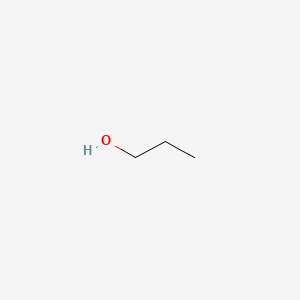
|
Anandamide |
Anandamide is a lipid of Fatty Acyls (FA) class. Anandamide is associated with abnormalities such as Dehydration. The involved functions are known as Process, Phenomenon, Phosphorylation, Catabolic Process and Gene Expression. Anandamide often locates in Nuchal region, Microglial and Hepatic. The associated genes with Anandamide are SGPL1 gene, SPTLC1 gene, RPSA gene, KDSR gene and SMPD1 gene. The related lipids are Sphingolipids, Lipopolysaccharides, Lysophospholipids, LYSO-PC and lysophosphatidylethanolamine. |
4747 |

|
4-hydroxynonenal |
4-hydroxynonenal is a lipid of Fatty Acyls (FA) class. 4-hydroxynonenal is associated with abnormalities such as Chronic disease, Obesity, Diabetes, Acquired Immunodeficiency Syndrome and Lung diseases. The involved functions are known as protein expression, Glycolysis, mRNA Expression, Regulation and Mitochondrion in division. 4-hydroxynonenal often locates in Muscle, Mitochondria, Adipose tissue, Head and Mouse Muscle. The associated genes with 4-hydroxynonenal are STAT3 gene, SIRT1 gene, PGC gene, IL6 gene and cytochrome c''. The related lipids are Lipopolysaccharides, Lipid Peroxides, Promega, Membrane Lipids and oxidized lipid. The related experimental models are Mouse Model, Knock-out, Transgenic Model, Disease model and Rodent Model. |
5685 |

|
PGD2 |
Pgd2 is a lipid of Fatty Acyls (FA) class. Pgd2 is associated with abnormalities such as Inflammatory disorder, Pleurisy, Rhinitis, Dehydration and Pneumonia. The involved functions are known as antagonists, fat cell differentiation, Phosphorylation, Process and Gene Expression. Pgd2 often locates in Cell surface, Body tissue, Extracellular, Bone Marrow and Membrane. The associated genes with PGD2 are oxytocin, 1-desamino-(O-Et-Tyr)(2)-, P4HTM gene, PTGS2 gene, PTGDS gene and IL3 gene. The related lipids are 15-deoxyprostaglandin J2, Nonesterified Fatty Acids, Lipopolysaccharides, Steroids and Liposomes. The related experimental models are Knock-out and Rodent Model. |
6464 |

|
1-propanol |
1-propanol is a lipid of Fatty Acyls (FA) class. |
6697 |

|
Platelet activating factor |
Platelet activating factor is a lipid of Glycerophospholipids (GP) class. Platelet activating factor is associated with abnormalities such as Atherosclerosis, Acute cholecystitis without calculus, Cholecystitis, Colitis and Cholecystitis, Acute. The involved functions are known as Cell Survival, Metabolic Inhibition, lipid oxidation, Apoptosis and Oxidation. Platelet activating factor often locates in soluble, Cellular Membrane, Smooth muscle (tissue), Intima and Tissue specimen. The associated genes with Platelet activating factor are apolipoprotein A-I Milano, Homologous Gene, TSPO gene, HBEGF gene and SLC33A1 gene. The related lipids are Hydroxycholesterols, Liposomes, 25-hydroxycholesterol, Lysophosphatidylcholines and Lipopolysaccharides. The related experimental models are Knock-out, Mouse Model and Transgenic Model. |
7383 |

|
Azithramycine |
Azithramycine is a lipid of Polyketides (PK) class. Azithramycine is associated with abnormalities such as Respiratory Tract Infections, Pneumonia, Lower respiratory tract infection, Infection and Nonspecific urethritis. The involved functions are known as Lysis, Selection, Genetic, Mutation, Relapse and Adaptation. Azithramycine often locates in Blood, Respiratory System, Genitourinary system, Back and Chest. The associated genes with Azithramycine are Genes, rRNA, Genome, RPL22 gene, OPRM1 gene and tryptic soy broth. The related lipids are Liposomes, Phosphatidylserines, Promega, Lipopolysaccharides and Steroids. The related experimental models are Mouse Model, Knock-out and Tissue Model. |
7835 |

|
2,5-diaminopentanoic acid |
2,5-diaminopentanoic acid is a lipid of Fatty Acyls (FA) class. The involved functions are known as Vasodilation, Intestinal Absorption and Pinocytosis. 2,5-diaminopentanoic acid often locates in Mitochondria, Microfilaments, NADH dehydrogenase complex and respiratory chain complex III location sensu Eukarya. The associated genes with 2,5-diaminopentanoic acid are GAPDH gene and iberiotoxin. |
8868 |

|
minocycline |
minocycline is a lipid of Polyketides (PK) class. Minocycline is associated with abnormalities such as Infection, Soft Tissue Infections, Septicemia, Chronic hyponatremia and Lesion of brain. The involved functions are known as Pharmacodynamics, Gene Expression, Transcriptional Activation, Regulation and Process. Minocycline often locates in Ribosomes, 50S ribosomal subunit, Blood, Skin and Immune system. The associated genes with minocycline are THEMIS gene, KCNK2 gene, RBFOX3 gene, PIWIL2 gene and P4HTM gene. The related lipids are Lipopolysaccharides, Promega, Steroids, Liposomes and Octanols. The related experimental models are Mouse Model, Experimental Autoimmune Encephalomyelitis, Genetically Engineered Mouse, Disease model and spinal model. |
9780 |

|
Thromboxane b2 |
Thromboxane b2 is a lipid of Fatty Acyls (FA) class. Thromboxane b2 is associated with abnormalities such as endothelial dysfunction, Diabetes Mellitus, Non-Insulin-Dependent, Diabetes Mellitus, Ischemia and Thrombocytosis. The involved functions are known as Platelet Activation, Excretory function, Anabolism, Inflammation and mRNA Expression. Thromboxane b2 often locates in Endothelium, Hepatic and Microsomes, Liver. The associated genes with Thromboxane b2 are PTGS2 gene, prothrombin fragment 2 and CCL14 wt Allele. |
10175 |

|
DHA |
Dha is a lipid of Fatty Acyls (FA) class. Dha is associated with abnormalities such as Atherosclerosis, Consumption-archaic term for TB, Chronic disease, Cardiovascular Diseases and Diabetes Mellitus, Non-Insulin-Dependent. The involved functions are known as Inflammation, Oxidation, fatty acid oxidation, Fatty Acid Metabolism and Lipid Metabolism. Dha often locates in Hepatic, Protoplasm, Mucous Membrane, Epithelium and outer membrane. The associated genes with DHA are IMPACT gene, FATE1 gene, GAPDH gene, THOC4 gene and SLC33A1 gene. The related lipids are stearidonic acid, Fatty Acids, Total cholesterol, Lipopolysaccharides and Dietary Fatty Acid. The related experimental models are Mouse Model, Transgenic Model, Animal Disease Models and Arthritis, Experimental. |
11054 |









